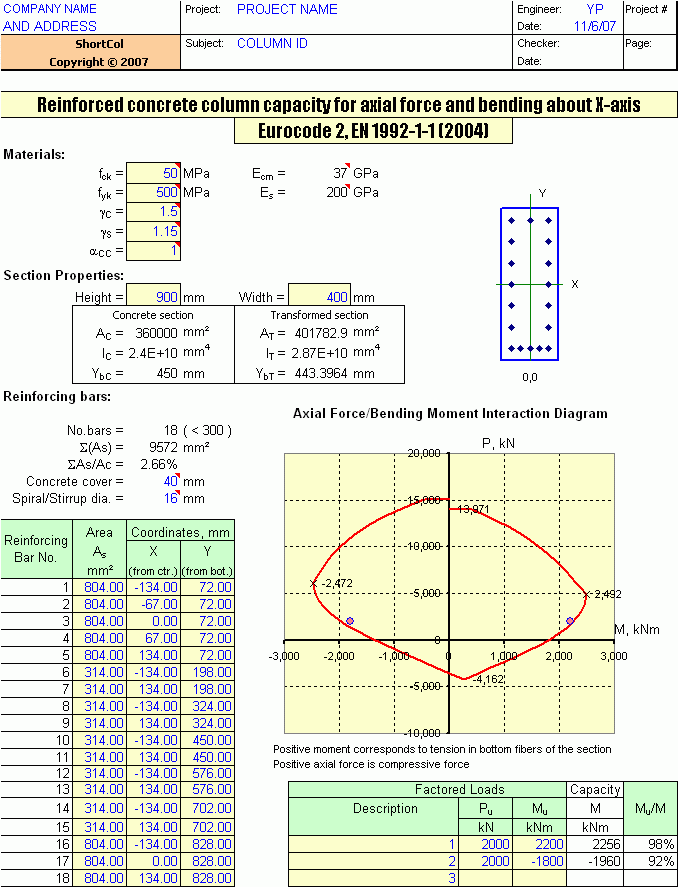- Crack Width Calculation Spreadsheet Download
- Crack Width Calculation Spreadsheet
- Crack Width Calculation Spreadsheet 2019
The short review of three crack width calculation methods (RILEM, supplemented EC2 and corrected EC2) of steel fibre and ordinary reinforced concrete flexural members is presented in this paper. Bridge Design and Assessment Spreadsheets. These Design and Assessment Spreadsheets were written using Microsoft Excel 2000 and 2010 and they contain macros. Excel will need to be set to 'Enable Macros'. Warning: The layout of the spreadsheet should not be changed. The macros carry out calculations using values from specific cells in the.
JavaScript must be enabled in order to use this site.
Please enable JavaScript in your browser and refresh the page.
Indian or British Codes
IS 456 - 2000 Annex F and BS 8110 Part II, Clause 3.8 include the same method for determining the nominal crack width for design. This procedure is based on work by Andrew Beeby. The crack width determined by this method represents a best-fit for experimental data where the stress in the tension steel is limited to 0.8x Fy.
The following assumptions are made for this method:
- Sm = 1.5 acr
- Wmean is a funciton of Sm and εm
- Wmax = 2x Wmean
The following procedure is then used by the program to evaluate the crack width for design:
Calculate the modular ration, m as:
m = Ec/Es
Where:
Es = 20,000 N/mm2 (IS 456 - 2000, Annex F)
Ec = 5,000·√(fc) (Cl. 6.2.3.1 of IS 456 - 2000)
Calculate the depth of the neutral axis, x, per the limit state method (IS 456 - 2000 Annex G and BS 8110 Part I Cl. 3.4.4.4)
- Calculate the moment of inertia of the equivalent section, Ieff.
Calculate the effective modulus of elasticity of concrete, Eeff.
Where:
c = safety factor taken as 1.0.
- Calculate the average steel strain at the depth considered (e.g., the centerline of rebar), ε1, based on the absolute value of the critical bending moment.
Calculate the average strain, εm, at the point of interest as:
Calculate Crack Width W_cr from IS 456 -20000 BS 8110 Part II
Where:
acr = distance from the point of interest to the surface of the nearest longitudinal bar
h = total depth of the section
Cmin = clear cover to longitudinal steel
Check whether the crack width value is safe or not depending upon the maximum allowed range defined by codes (IS 456 2000 & BS 8110 Part II)
Eurocode 2 part 1-1: Design of concrete structures 7.3 Crack control
The crack width, wk, may be calculated as follows:
| wk = sr,max⋅(εsm - εcm) | (7.8) |
where:
- sr,max
- is the maximum crack spacing
- εsm
- is the mean strain in the reinforcement under the relevant combination of loads, including the effect of imposed deformations and taking into account the effects of tension stiffening
- εcm
- is the mean strain in the concrete between cracks.
| (7.9) |
where:
see application for a rectangular section or application for a T-section


Crack Width Calculation Spreadsheet Download
Es/Ecmwith
- Ecm
- the secant modulus of elasticity of concrete
fct,eff = fctm or lower, (fctm(t)), if cracking is expected earlier than 28 days
| = (As + ξ1⋅A'p)/Ac,eff | (7.10) |
with
| ξ1 = | (7.5) |
with
- ξ
- the ratio of bond strength of prestressing and reinforcing steel, according to Table 6.2
- ΦS
- the largest bar diameter of the reinforcing steel
- ΦP
- the diameter or equivalent diameter of prestressing steel:
Φp = 1,6⋅√AP for bundles, where AP is the area of a prestressing steel,
Φp = 1,75⋅Φwire for single 7 wire strands,
Φp = 1,20⋅Φwire for single 3 wire strands, where Φwire is the wire diameter.
kt = 0,6 for short term loading,
kt = 0,4 for long term loading.
• Where the bonded reinforcenlent is fixed at reasonably close centres within the tension zone (spacing ≤ 5(c + Φ/2), cf. Figure 7.2), the maximum crack spacing sr,max may be calculated as follows:
| sr,max = k3c + k1k2k4Φ / ρp,eff | (7.11) |
where:
k1 = 0,8 for high bond bars,
k1 = 1,6 for bars with an effectively plain surface (e.g. prestressing tendons).
k2 = 0,5 for bending,
k2 = 1,0 for pure tension.
Intermediate values of k2 should be used for cases of eccentric tension or for local areas:
| k2 = (ε1 + ε2)/(2ε1) | (7.13) |
where ε1 is the greater and ε2 is the lesser tensile strain at the boundaries of the section considered, assessed on the basis of a cracked section.
• Where the spacing of the bonded reinforcement exceeds 5(c + Φ/2) (cf. Figure 7.2), or where there is no bonded reinforcement within the tension zone, the maximum crack spacing sr,max may be calculated as follows:
| sr,max = 1,3(h - x) | (7.14) |
where:
Crack Width Calculation Spreadsheet
- h
- is the overall depth of the section (see Figure 7.1)
- x
- is the neutral axis depth of the section (see Figure 7.1).
This application calculates the crack width wk from your inputs. Intermediate results will also be given.
Crack Width Calculation Spreadsheet 2019
First, change the following option if necessary:

